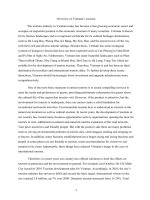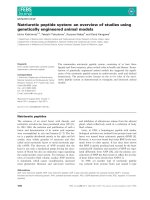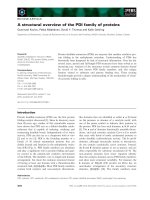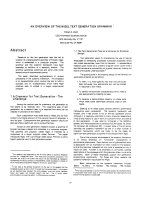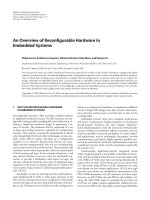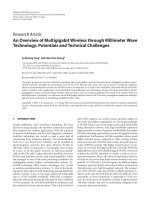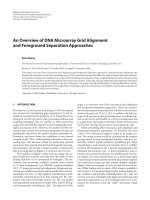OVERVIEW OF BANKCARD
Bạn đang xem bản rút gọn của tài liệu. Xem và tải ngay bản đầy đủ của tài liệu tại đây (197.84 KB, 33 trang )
CHAPTER ONE: OVERVIEW OF BANKCARD
1.1. General introduction about bankcard
1.1.1 History of bankcard
Bankcard history began when individual retail merchants extended credit to their
customers, allowing them to charge purchases to an account held by the merchant.
In 1730, Christopher Thompson, a furniture merchant, created the first
advertisement for credit by offering furniture that could be paid off weekly. However,
1950 marked the real beginning of the credit card most of us are familiar with today.
Diner’s Club, Inc. introduced the first credit card that could be used at a variety of
stores and businesses. Advantages of this card immediately took notice of many
people.
In 1960, Bank of American introduced its own bankcard, the BankAmericard. In
1966, fourteen United States banks formed Interbank, a new association with the
ability to exchange information on credit card transactions. The following year, 1967,
four California banks changed their named from the California Bankcard Association
to the Western States Bankcard Association (WSBA). The new WSBA licensed
Interbank to use the MasterCharge name and logo. In the late 1960s, numerous
financial institutions became MasterCharge (Interbank) members to compete with
BankAmericard. Eventually, financial institutions interested in issuing cards in the
U.S. became members of either BankAmericard or MasterCharge. In 1977,
BankAmericard became Visa USA/ Visa International. In 1979, MasterCharge
changed its name to MasterCard to reflect its expanded services. At the present time,
the leaders in the bankcard systems are Visa, Master Card, Amex and JCB.
Payment by bankcard quickly become popularity in other countries. In 1960, the
first plastic card was used in Japan marked the beginning of bankcard in Asia. The
first plastic card of Barcaly Bank issued in 1966 also highlighted a new period of
development of bankcard in Europe.
In Vietnam, the first card was accepted in 1990. It was the starting point for
card’s products and services in Vietnam. Nowadays, bankcard presents all over the
world in diversified forms which meet every demand of cardholders. Banks and
financial institutions always try to improve bankcard to reach a friendly and
convenient payment method for customers.
1.1.2. Concept and classification
Everyday millions of people all around the globe are using bankcards for
making credit card payments for their purchases. However, the fact that not every
cardholders know concept of a bankcard
* Concept:
.In simple terms: A bankcard can be described as a plastic card issued by a bank or
a financial institution, using which, the cardholder can gain access to the financial
resources of the bank as a line of credit.
* Classification:
There are many types of cards that can be used as alternative forms of payment.
Financial institutions issue some and banks issues others. Many allow the balance to
be paid in full each month. Some take the payment directly from the cardholder’s
bank account while others require that the cardholder send payment to the issuer.
Herein, I list some popular ways to divide bankcards.
Figure 1. - Types of bankcards
Source: Developed for the report
* Payment method:
- Debit card: A plastic card used to initiate a debit transaction. In general, these
transactions are used primarily to purchase goods and services and to obtain cash, for
which the cardholder's asset account is debited by the issuer
Debit card consist two basic types:
+ On-line debit card: An online-debit card deducts funds from the bank account
immediately, as soon as the card is used. There is no delay for processing the
transaction
+ Off-line debit card: An off-line debit card does not deduct funds from the
checking account immediately. Transactions are processed like a regular credit card
and the funds are not deducted for 24-72 hours.
D
e
b
i
t
c
a
r
d
Payment
method
Area of
Using card
I
n
t
e
r
n
a
t
i
o
n
a
l
c
a
r
d
Technical
Feature
Issuer
C
r
e
d
i
t
c
a
r
d
M
a
g
n
e
t
i
c
s
t
r
i
p
e
c
a
r
d
S
m
a
r
t
c
a
r
d
B
a
n
k
c
a
r
d
s
T
r
a
v
e
l
a
n
d
E
n
t
e
r
t
a
i
n
m
e
n
t
c
a
r
d
s
D
o
m
e
s
t
i
c
c
a
r
d
C
a
s
h
c
a
r
d
Cards
Most issuers of debit cards are moving to this type of card rather than on-line
debit card
- Credit card: A plastic card bearing an account number assigned to a cardholder
with a credit limit that can be used to purchase goods and services and to obtain cash
disbursements on credit, for which a cardholder is subsequently billed by an issuer for
repayment of the credit extended at once or on an installment
basis
- Cash card: Cash cards are similar to pre-paid phone cards. The card is worth a
certain amount of cash and the retailer must use a special cash card reader to debit the
card. Each purchase is deducted from the value left on the card until the pre-paid
amount is spent. These cards are just like cash – if lost or stolen, there is no way to
retrieve the money on the card.
* Technical feature:
- Magnetic stripe card: The magnetically encoded stripe on the bankcard plastic
that contains information pertinent to the cardholder account
- Smart card: The smart card, also known as the chip card, contains a computer
chip embedded in the plastic. When read by a special terminal designed to interact
with the embedded chip, the card can perform a number of functions or access data
stored in the chip. These cards can be used as cash cards or as credit cards with a
preset credit limit.
* Issuer:
- Bankcards: Banks, financial institutions around the world distribute cards. A
cardholder borrows money against a credit line and repays those funds with interest if
the balance is carried over from month to month.
These cards are used all around the world, such as: Visa USA, MasterCard…
- Travel and entertainment cards: travel and entertainment corporations
distribute their own cards so they are not considered bankcards since they are not
issued by a financial institution. These cards are widely used by business for their
travel and entertainment expenses, such as American Express (AMEX), Dinners
Club…
* Area of using card:
- Domestic card: Card is used in domestic only with legal tender of that nation.
- International card: Card is used around the world, used strong currencies in
transactions.
1.2. Cards’ activities in commercial banks
1.2.1. Entities join card activities
Figure 2. - Participants in bankcard transactions
Source: Developed for the report
The figure shows 5 entities joining a bankcard transaction.
* International card organizations: (ICO)
For example MasterCard or Visa International/Visa USA, they are worldwide
payment service organization composed of member institutions. They set and enforce
rules and regulations governing operational procedures, interchange procedures, and
graphic design approval of their cards…
These organizations do not have a direct relationship with cardholders and
merchants.
Any bank has international card must be a member of an ICO
The issuing
members
International
card
organization
The acquiring
members
Merchant
Cardholders
* The issuing members: The cardholder’s financial institution (usually called the
issuing member, or issuer) is a licensed member of an ICO. The issuer directly issues
the card to the approved cardholder. The issuer may also benefit from services of a
third party processor and/or association in processing information and payments.
* The acquiring members:
The acquiring members, or acquirer, solicits, screens and accepts merchants into
its bankcard program. The acquirer is also a member of an ICO, and holds a written
agreement with the merchant to:
- accept the merchant sales drafts
- provide the merchant with credit card authorization terminals, instructions, and
contracted support services
- handle and process the credit card transactions
The acquirer usually charges the merchant a merchant discount for handling the
transactions. The acquirer is licensed by an ICO agrees to follow the operating rules
and regulations of the two associations.
In fact, many banks and financial institutions are both issuers and acquirers. As
issuers, they maintain the cardholder relationship. As acquirers, they maintain the
merchant relationship.
* Cardholders:
The customer to whom a card has been issued or the individual authorized to use
the card .
The cardholder uses the bankcard either to purchase goods and services from a
merchant, or to obtain a cash advance from a member for which the cardholder
receives a monthly bill from the issuer.
* Merchant:
The merchant can be virtually any company which meets the qualification
standards of an ICO and an acquirer.
The ICO usually require that the merchant be financially responsible and good
repute. The merchant has a written agreement with the acquirer to accept the
bankcards as a payment and to abide by the terms of the agreement.
1.2.2. Transaction process
* Issuing:
Figure 3.- Procedure of issuing bankcard
Source. Developed for the report
+ Customer
- Customers fulfill and sign on the application and credit card agreement
- Required documents: photograph 3x4 or 4x6, Copies of Identity card, copies of
passport, visa or residence permit…
- Types of guarantee for card payment.
+ Issuing banks
- Checking customer’s application, then decide to approve or not
- Approval: send customer’s request of opening card to card centre
- Receiving new card and personal identity number (PIN) from card centre
- Handing card and PIN over customer
Customer
Application
Approval
Guide of using
Handing card
and PIN over
Receiving new
card and
PIN from centre
Registration of
issuing
- Guiding customer to use card
+ Card centre
- In responsibility of receiving information of customer from issuing banks
- Produce new card
- Deliver card to issuing banks
* Acquiring:
Figure 4.- Procedure of acquiring cards
Source. Developed for the report
The acquiring procedure beginning with the cardholder:
(1) - The cardholder purchases goods or services from the merchant
(2), (3) - The merchant, in effect, sells the transaction to the acquire and is
reimbursed the amount of the sales ticket by the acquirer
(4) - The acquirer then summits the ticket to the issuer for payment, via the ICO
interchange and settlement system.
(4)
(3)
(2)
(1)
Cardholder
Issuing
members
International
card
organization
Merchant
Acquiring
members
(5)
(6)
(5) - The issuer bills the cardholder
(6) - Finally, the cardholder repays the issuer for the goods or services originally
purchased from the merchant.
ICO are at the centre of the transaction process, maintaining the flow of funds
and information between issuing and acquiring members.
The exchange of financial information is called clearing. The exchange of the
actual funds for the transaction and the fees associated with them is called settlement.
The term used to refer to the clearing and settlement system as a whole is interchange.
CHAPTER TWO. THE ROLE OF MARKETING ACTIVITIES TO
BANKCARD AND ACTUAL STATE OF AGRIBANK CARDS
2.1. Introduction of Vietnam Bank for Agriculture and Rural Development
(Agribank) - Thanh Xuan branch
2.1.1. Foundation and development of Agribank Thanh Xuan
In 2007, Vietnam Bank for Agriculture Development - Thanh Xuan branch was
founded under Decision No 1292/QĐ/HĐQT/TCCB dated November 29th, 2007 by
the Board of Directors of Agribank with the primary staff of 36 people.
Located in 90 Lang Street, Thanh Xuan District, a vast residential area with
many convenient economic conditions, Agribank Thanh Xuan has many advantages
to do business effectively. Thanh Xuan branch operates its business mainly on Thanh
Xuan District and other Districts in Hanoi. Being in the strategy of organization
network development of Agribank, Agribank Thanh Xuan has played an important
part in improvimg business performance of Agribank, as well as contributed to shift
economic structure, promoted the further economic-social development of Thanh
Xuan District in a comprehensive and sustainable way.
Since establishment, Agribank Thanh Xuan has continuously extended trading
networks, diversified items of business, currency, and credit, promoted capital
sources. The branch is also focusing on improving the qualification of staff both in
professional knowledge and skills as well as foreign languages, concerning about
stabilizing and raising the networking and living conditions of employees. Facilities
are modernized, especially information technology, to serve the business better. From
establishment, the branch always makes profits, the revenue is higher year after year,
contributing to State budgets increasingly, creating credibility with customers.
Source. Secondary data of Administration Department of Agribank Thanh Xuan
The pie chart shows the education degree of staff in the branch. Staff and
employee in the branch has high education degree 86% of bachelor, major in
economics, banking or financial field. With a skillful and high education degree of
work force, it is one of the most important advantages to build a strong and
sustainable branch. Continuously developed and widened, the staff and employees in
the branch has raised to 72 people at the present time.
2.1.2. Organization structure
Through years of operation, Agribank Thanh Xuan has developed widely, at the
present time it has a business network of five dealing rooms. They are: Thirty two
(32), thirty three (33), thirty four (34), forty six (46) and Cat Linh dealing room..
Agribank Thanh Xuan is organized under the model of a supervisor Board of
Management including General Director and two Deputy Directors.
Organization structure of Agribank Thanh Xuan is divided into functional
blocks as follows:
Figure 7.- Organization Chart
Source. Secondary data of Administration Department of Agribank Thanh Xuan
2.1.3. Products and services
Agribank has been made an effort in developing traditional services as well as
other modern and valued added services. This has enabled Agribank to diversify its
own products suitable to each segment of customers. At the present time, Agribank
becomes leading bank in developing products: Mobile banking, SMS banking,
VNTop up, SMS remittance ( A transfer service), etc.
To Agribank Thanh Xuan, inherited reputation and successes of Agribank, the
branch has its decisions, policies to proceed those successes. Agribank Thanh Xuan
posts in the account dependently, has its own seals, organizes and operates under
Services &
Marketing
Department
Administration
Department
Cát Linh
Deputy
Director
D
463433
32
General Director
Internal
Supervision
Deputy
Director
Plan &
Business
Department
Accounting
& Treasury
Department
Dealing
Rooms
Regulation on organization and operation of Agribank. Agribank Thanh Xuan
provides products and services which serve:
- Personal customers: They are individual, households join transactions in the
branch. The branch provide these customers: Individual account, loans, savings and
investment, remittance, Agribank card, foreign exchange
- Corporate customers: They are target customers of the branch. Money flow
often in a great number. They are organizations, corporate… Services and products
include: guarantee service, international payment, account, lending, check services,
valuable notes, payment, border payment, saving deposit, leasing, foreign exchange,
factoring
- Financial institutions: Agribank hope to “provide various services in order to
satisfy customers coming from financial institution sectors”. These services are: retail
banking, foreign exchange, treasuring, financial trading, project based lending.
2.2. Marketing activities at Agribank Thanh Xuan
2.2.1. Organization of Services and Marketing Department
Figure 8. Services and Marketing Department
Source. Secondary data of Administration Department
Services and Marketing Department has 6 staff with separate tasks and roles in
their own working field:
Head of
Department
International
Payments
Section
Card Section
